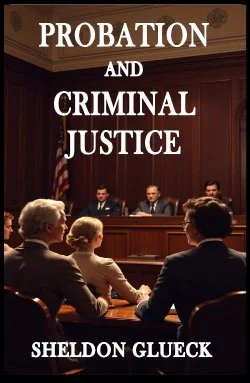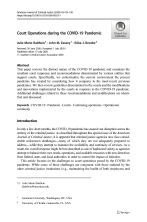By Scottish Government, Social Research
In late 2019, the Scottish Government commissioned an independent research study into decision making in relation to refusal of bail in Scotland. The overall aim of the research was to explore how decision making works in practice, as well as to gather perceptions on bail options. The research was carried out over two phases. Phase 1 involved online surveys of members of the Judiciary and Crown Office and Procurator Fiscal (COPFS) staff, the findings from which were published in an Interim Findings report in July 2022.
This report presents findings from Phase 2 of the research which involved a series of qualitative interviews with key justice stakeholders (Sheriffs, COPFS staff, defence solicitors and social work staff) to add breadth and context to the survey data presented in the Phase 1 report. A case study approach was taken with fieldwork carried out in six different case study areas, selected on the basis of broad geographical coverage, as well as a mix of courts (from different Sheriffdoms) where historical data (provided at the outset of the project by the Scottish Courts and Tribunals Service) showed high, medium and low levels of remand. All participation was on a voluntary, self-selection basis and all interviews were carried out on a one-to-one or two-to-one basis, using either face-to-face, online or telephone interviews. A total of 60 people took part over a six month period.
Main Findings
The research highlights that the bail and remand decision making process is complex, multi-faceted and time pressured. The ‘jigsaw’ of legislation, combined with circumstance and human factors, means that no two cases are ever treated the same way and no response can ever be seen as ‘typical’. All participants across all stakeholder groups agreed that the decision making process was informed by multiple considerations in each case, and that there was never any one factor which was determinative in its own right. All cases were described as being unique and as being treated on the basis of the information available at the time and the merits of each individual case. Similarly, while some factors may carry more weight in some circumstances, all factors are still considered in their totality.
Findings from the research broadly fell under four key topics, these being: Legislative Grounds, Process and System Influences, Human Factors and Other Considerations. The main findings presented below are structured around these four topics, with a fifth separate dedicated section focusing on Alternatives to Remand.
(1) Legislative Grounds
The Criminal Procedure (Scotland) Act 1995 is the cornerstone of all decision making and was described by all stakeholders as the main framework within which all decisions on bail and remand are made, being of equal relevance and influence in both summary and solemn cases.
Most respondents concurred that a combination of all of the factors set out in Section 23C of the 1995 Act, alongside the particular facts and circumstances of a case, determined all decisions about whether an accused presents a risk of re-offending and whether bail should be opposed. In general, however, the nature of the offence (especially where the accused has a history of similar, recent offending) and previous convictions were the two factors which perhaps carried the most weight in decisions to oppose bail (by COPFS) and to refuse bail (by Sheriffs).
The nature (including level of seriousness) of offences before the court was described as “highly influential” in Crown decisions to oppose bail primarily because it was seen as the key indicator of the danger that the accused may present to the public and witnesses. Sheriffs also stressed that the seriousness of the current offence was paramount in their determinations (with decisions in solemn procedure even more likely to have seriousness at their heart than summary procedures).
The nature of any previous convictions of the person (including analogous offending) was described by the Crown as “highly influential” in their case marking, and could be sufficient for opposing bail on its sole merit (especially if previous offending was very similar to the new offending). It was noted that the nature of previous convictions could demonstrate that the accused has a preferred method of offending, as well as demonstrating risk of commission of further offending and/or being of danger to the public. Offence histories were also the second most frequently cited factor influencing Sheriffs’ decisions.
Previous behaviour whilst on bail (including compliance, previous breaches and previous breaches of other court orders) was described by Sheriffs as being “very commonly relied upon by the Crown and the court”, with COPFS respondents noting that it often indicated concerns as to commission of further offences, future failure to comply with bail conditions, failure to surrender and likelihood of custody (with breach of orders suggesting contempt of same). Similarly, solicitors noted that the record of the accused alongside their compliance with previous orders played heavily in their assessment of likelihood of bail being granted. Sheriffs confirmed that previous behaviour while on bail was considered as a key indicator of likely future behaviour in the current case.
How recently other offences were committed was described as playing a key role in decisions as it could help to demonstrate any pattern of offending or risk of re-offending and whether the accused was targeting a single or multiple victims/complainers. This information was also described as useful insofar as it may yield arguments that certain specific sections of society are not safe if the accused was to be at liberty. A period of desistance following a prolific record was not always seen as good reason to support bail, and it was noted that the weight of the record and other factors were also likely to be considered by COPFS and Sheriffs in turn.
Evidence of escalation of offending was perhaps seen as slightly less influential than other features of an accused’s history and was often considered only alongside other features (in particular the types of offending being escalated) to present a case for opposing bail by the Crown. For Sheriffs, escalation was also not a primary determinative factor in decisions.
Of lower importance in the order of considerations for Sheriffs was the risk of failure to appear at future court diets. While previous behaviour was seen to be indicative, Sheriffs tended to note that failure to appear would need to be severe, prolonged and prolific for this to be the reason why they would remand someone to custody.
Sheriffs also cited risk to public and community safety as being key to their decision making, and possibly one of the most significant factors weighing in bail/remand decisions, after offence nature and seriousness (the two often being intertwined). Assessing whether the accused was likely to interfere with victims/witnesses was also seen as important, although it was noted that interference was ‘rare’ in most types of case (the exception being domestic abuse/harassment cases). Similarly, most Sheriffs cited the nature and number of previous offences and previous non-compliance with bail and other court orders as a key consideration involved in assessing ‘substantial risk’.
Also in relation to legislative grounds, Section 23D of the Act (which sets out a presumption against bail for those accused of violent/sexual/domestic abuse offences or drug trafficking offences in solemn proceedings, where they have a previous conviction of a similar nature) was viewed as being interpreted very differently by different Sheriffs. Stakeholders viewed that ‘exceptional circumstances’ (which may allow the granting of bail in some such cases) was a (largely) undefined, fluid and subjective concept. Sheriffs and solicitors also concurred that there was a certain inevitability of bail being opposed by COPFS in Section 23D cases. It should be noted, however, that the Bail and Release from Custody (Scotland) Act 2023 (which was still being passed through parliament at the time that the research was reaching its conclusion) repeals Section 23D of the Criminal Procedure (Scotland) Act 1995. (continued)
Edinburgh: Safer Communities Directorate, 2023. 93p.





















